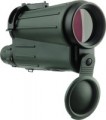Field of view 1 km away
The field of view of the telescope at a distance of 1 km to the objects under consideration, the so-called "linear field of view". In fact, this is the width (diameter) of the space that falls into the field of view when observed from a distance of 1 km.
This parameter is widely used in the characteristics of telescopes along with the angular field of view (see below): the linear field of view data is more visual and closer to practice, it allows you to evaluate the capabilities of a telescope without resorting to special calculations.
For models of variable magnification (the majority of them), the linear field of view is indicated in the form of two numbers — for the minimum and for the maximum magnification.
Angle of view
Angle of view provided by a telescope.
If you draw two lines from the centre of the lens to two opposite points along the edges of the field of view of the pipe, the angle between these lines will correspond to the angular field of view. Accordingly, the larger the angle, the wider the field of view; however, individual items in it will look smaller. Conversely, an increase in magnification is inevitably associated with a decrease in the viewing angle. And since most modern telescopes have a variable magnification, the angular field of view is also variable, and in the characteristics this indicator is indicated in the form of two numbers — for the minimum and for the maximum magnification.
Prism type
The type of prisms used in the construction of the telescope (if prisms are provided at all).
—
Roof. A Roof prism does not change the direction of light entering it — the light beam goes through several internal reflections and exits in the same direction and at the same level as it entered. Such prisms are used in models with a direct arrangement of the eyepiece; they allow you to increase the focal length of the telescope and achieve high magnification without a significant increase in the length of the device itself.
—
Porro. A classic prism of this type provides a "reversal" of the light entering it by 180 °; because of this, Porro are used at least in pairs. They are used in almost all telescopes with eyepieces located at 45 °, as well as in "straight" models, in which the eyepiece is offset relative to the optical axis of the lens (usually upwards). For the advantages of the first option, see "Eyepiece Positions"; and placing the eyepiece above the lens reduces the length of the telescope, moreover, in some situations, this arrangement is the most convenient. Like the Roof, Porro prisms provide an increase in focal length; however, they are considered to give a wider field of view and good image depth. The disadvantage of this option is the increase in the dimensions of the pipe in height.
Prism material
The material used for prisms mounted in a telescope (see "Type of Prisms").
—
BK7. A variety of borosilicate optical glass (crown), a relatively inexpensive and at the same time quite functional material that provides, although not outstanding, but quite acceptable image quality. It is used in models of initial and intermediate levels.
—
BaK4. Barium optical glass, which is noticeably superior to BK7 in terms of brightness and image clarity, but also more expensive. Found mainly in premium spyglasses.
Shockproof
The presence of additional
protection against impacts in the design of the spyglass body.
Any case is able to withstand impacts to a certain extent, however, this feature is indicated only for those models in which additional means of protection against impacts are specially provided — soft shock-absorbing material of the case (for example, rubber), elastic inserts, special lens mounts, etc. The specific degree of impact resistance of such a telescope can be different, this point should be clarified according to the manufacturer's documentation. However, usually, shock protection implies the ability to normally endure a fall from a height of at least a metre onto a flat hard surface.

